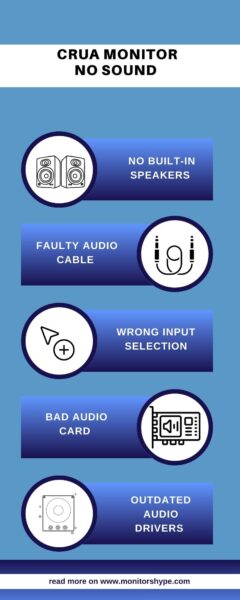Last week, I was excited to set up my new Crua monitor with my gaming PC. However, when I connected everything and tried to play my favorite game, the monitor produced no sound. Initially, I suspected a loose connection, but the issue persisted and required further investigation. After researching, I found several solutions to this problem.
In this article, we’ll explore the possible causes and fixes for why your Crua monitor might not be producing sound.
Why Does My Crua Monitor No Sound
There could be several reasons why your Crua monitor isn’t producing any sound.
It could be due to problems with your audio settings, a faulty speaker, or issues with your computer’s sound card.
To troubleshoot, start by checking the volume settings on your monitor and ensure that it is not muted.
If that doesn’t work, try updating the audio driver in your computer’s operating system.

1. No built-in Speakers
Before any troubleshooting, you should ensure that your monitor has come equipped with built-in speakers.
To determine if your monitor has built-in speakers, you will need to examine the product specifications, which are usually listed in the user manual or the manufacturer’s website.
Look for the mention of ‘audio,’ ‘sound,’ or ‘speakers’ in the specifications.
You can also look over the monitor itself for speaker grills or audio-out ports. These signs suggest the presence of built-in speakers.
If you still can’t find any information, the monitor might not have a built-in speaker, and you may need external speakers or headphones for audio.
2. Faulty Audio Cable
The audio cable serves as the connection between the monitor and the computer; sometimes, it can malfunction, impeding the audio transmission.
It can be damaged due to physical damage like bending or breaking or internal issues such as wire fraying.
In that case, you should inspect the cable for any visible signs of damage, and testing it with another device can help diagnose the problem.
If you have confirmed that the cable is faulty, then immediately replace it with a new one.
3. Incorrect Audio Settings
Incorrect audio settings can also be the root cause of the lack of sound in your Crua monitor.
To fix the issue, ensure that the sound is not muted, the volume is at an appropriate level, and your speaker output is correctly selected.
Most operating systems have built-in troubleshooting tools that can automatically detect and fix common audio issues.
4. Wrong Input Selection
An often overlooked cause for a lack of sound in monitors can be attributed to incorrect input selection.
This typically occurs when the selected audio input doesn’t match the one connected to the sound source.
For example, if you plug an HDMI cable into your monitor, but the selected audio input is ‘DisplayPort,’ the monitor won’t produce sound.
Always ensure that your audio input selection matches the cable you are using for audio signal transmission.
To check this, navigate to the sound settings on your computer. For Windows, go to ‘Sound settings’ in the control panel, and under the ‘Playback’ tab, ensure your Crua monitor is selected as the default device.
For Mac users, go to ‘System Preferences,’ select ‘Sound,’ and then the ‘Output’ tab. Make sure your Crua monitor is selected.
5. Bad Audio Card
A faulty audio card can also cause your Crua monitor not to produce the sound.
The audio card, also known as the sound card, is responsible for outputting audio signals to the monitor.
If this card becomes defective or if its drivers become outdated, it may fail to perform its function, leading to the absence of sound.
Symptoms of a faulty audio card may be static noise, intermittent sound, or no sound at all.
To fix the issue, check the audio card to ensure it is not faulty; in the worst scenario, if it is, then replace it with a new one.
6. Outdated Audio Drivers
Outdated audio drivers can be a common cause of sound issues with your Crua monitor.
The drivers act as the bridge between the operating system and hardware devices, and when they’re outdated, it could lead to no sound.
In that case, you must update the audio drivers to get back sound from your Crua monitor.
Here are the steps to update the drivers:
- Open Device Manager by pressing the Windows key + X simultaneously and selecting the Device Manager option from the list.
- Click on “Sound, video, and game controllers” to expand it.
- Right-click on your audio device, which might be named something like “Realtek High Definition Audio.”
- From the drop-down menu, select “Update driver”.
- Choose “Search automatically for updated driver software.”
- Follow the on-screen instructions to install the new driver.
- Once the installation is complete, restart your computer to ensure the changes take effect.
7. Faulty Audio Port
A faulty audio port in your monitor can be a common cause of sound issues. If the audio port is damaged or malfunctioning, it can prevent headphones or speakers from transmitting sound correctly.
This could be due to wear and tear, a loose connection, or even dust and debris in the port.
To resolve this issue, you may need to get the audio port repaired or replaced by a professional.
8. Power Fluctuations
Power fluctuations, commonly referred to as surges or brownouts, can potentially damage electronic devices or disrupt their operation.
Power inconsistencies might lead to issues with the audio output, resulting in no sound.
These fluctuations can result from various sources, such as faulty wiring, overloaded power boards, or even larger-scale issues.
It’s crucial to safeguard your monitor with reliable surge protectors and to maintain a consistent power supply to keep your devices running optimally.
9. Contact Customer Support
If you’re still facing sound issues with your Crua monitor, then it might be time to get in touch with Crua customer support.
Customer support will be able to provide you further solutions or replacement/repair offers.
You may also love to read!
FAQ
How do I unmute my monitor?
Unmuting a monitor primarily depends on the model and make of the monitor.
However, a general approach involves navigating to the settings menu using the buttons located on the monitor itself.
Once you’ve opened the menu, look for audio settings. Here, you can adjust the volume or unmute the monitor if it’s muted.
If your monitor is connected to a computer, you can also adjust the volume via the sound settings on your computer.
Do cura monitors come with built-in speakers?
While Cura monitors are known for their high-resolution displays and advanced features, they typically do not come with built-in speakers.
As a result, you may often need to purchase external speakers or use headphones if they require audio capability.
